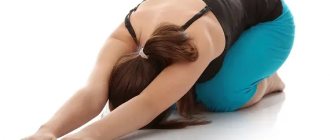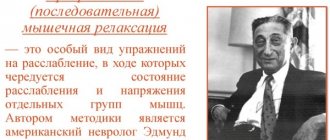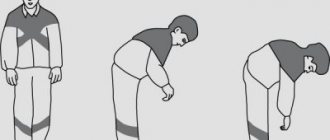From this article you will learn:
- What is post-isometric muscle relaxation
- What are the indications for post-isometric muscle relaxation?
- What exercises does post-isometric muscle relaxation include?
Postisometric muscle relaxation (PIRM) is a manual therapy-based procedure. This type of massage is only partially similar to manual massage, so it is separated into a separate category. The effects of PIRM are practically painless. Only slight muscle tension occurs, which does not cause discomfort at all. The procedure will not cause you any discomfort; it is accessible even to those people who have a high pain threshold. In this article we will tell you in more detail what post-isometric muscle relaxation is, what its features and nuances are.
What is post-isometric muscle relaxation
Any modern person with almost 100% probability has some kind of health problems. Most of us are busy working in offices or studying, which require staying in one position for a long time. This leads to tension, spasms, and immobility of the joints. The spine loses its flexibility.
Postisometric relaxation of the spinal muscles is directly related to manual therapy. But this method is somewhat different. It is more gentle and almost completely painless. The relaxation method was first used in 1906 by Dr. Puusel. He first tried it on his patients and realized that the traction method effectively relieves muscle and ligament tension. Based on the technology invented by Puusel, post-isometric relaxation was developed directly in America.
The procedure is very relaxing and removes tension. As a result, you gain lightness and energy. The body again becomes mobile and resilient.
Relaxation “only relaxation”
Once you have mastered the previous technique, you can try to achieve the same results, bypassing the tension stage. Focus on each muscle group in the order described above. Relax each of them for 30-45 seconds. Try to think about something pleasant or not think about anything at all. Once one muscle group is completely relaxed, move on to the next. If you cannot relax some muscles, use the “tension-relaxation” technique. When you are completely relaxed, complete the relaxation with a breathing exercise, counting from five to one and repeating the word “Relax...” as you exhale, then complete the exercise by counting down.
Step-by-step technique for post-isometric muscle relaxation
Certain relaxation exercises work on the muscles, loosening them and removing blockages. During the session, the person is on the floor or on a massage table. The specialist performs stretching with short movements. The focus is on blocked muscles. Some types of manipulation require the participation of the patient himself (for example, forcefully resisting a stretch). The intensity with which the master will work depends on the degree of muscle blockage. Of course, your feelings are taken into account. If necessary, the impact is reduced.
But even the most powerful manipulations are completely painless. Postisometric relaxation does not involve severe pain.
The wizard's procedure:
- First, the specialist abducts the joint that will be worked on to limit its movement. This is the first impact on the stressed area.
- As soon as the patient begins to feel pain, the joint is released.
- The contraction of the muscle will increase significantly if you continue to influence it.
- The muscle is stretched, and in the next stage you need to provide resistance without squeezing the muscles.
- The master acts precisely and briefly (within 5–7 seconds).
- Then there is a pause of up to 3 seconds.
- The manipulation is repeated about four times.
A post-isometric muscle relaxation session lasts from 30 to 45 minutes. At the same time, you will immediately feel the stretching of the muscles, and a pleasant lightness will occur. There may be slight pain in some areas. This is the body's natural reaction to stress. Then you will get used to it, and the discomfort will go away. For an effective result, you will need about ten sessions.
How can an HR professional help employees reduce stress?
We spend most of our time at work. That is why it is important for HR specialists to learn from the experience of Western colleagues, such as Google, and, if possible, organize the everyday life of staff more comfortably. What does that require?
Create relaxation rooms
And not only for games and evening gatherings. It’s good if the company has a quiet place where every employee can come and relax. You can place a soft sofa or bean bags in it. 15 minutes of peace and quiet will help restore strength and relieve stress.
Give yoga passes/massage certificates
Each company has its own so-called “buns”. Why not introduce a wonderful tradition of giving “employees of the month” or those who deserve encouragement a gift in the form of an opportunity to relax. Some companies enter into partnerships with various spa centers so that their employees receive discounts or certificates for certain services.
Give preference to healthy products
If your company provides free (or partially free) meals for employees, then with the right choice of products, an HR specialist can directly influence the mood of the staff. It is worth paying attention to:
- fruits (bananas, apricots, apples, strawberries, raspberries, blueberries);
- fish;
- green and herbal teas;
- cereals and cereals;
- black chocolate;
- nuts.
Organize team building activities in nature
Of course, when there is such an opportunity and the weather allows it. Office workers most often suffer from chronic stress and back pain. Walking in nature will not only bring the team together, but will also help the body recover after long hours of sitting.
Indications and contraindications for post-isometric muscle relaxation
In general, post-isometric relaxation is safe, there are practically no contraindications. But massage should not be performed for damaged skin, as well as acne (as the scars will become deformed, which can worsen the situation). The procedure is prohibited if you have a high temperature. Also, you should not perform it in case of infectious diseases.
In other cases, you can safely resort to PIRM. However, it is still important to consult a doctor, especially when it comes to relaxation exercises on your own.
Postisometric muscle relaxation is a soft manual technique. It involves a light, painless effect.
However, the method will be contraindicated if you have the following health problems:
- thrombosis;
- skin diseases;
- problems with the heart and blood vessels;
- ischemia;
- pulmonary failure;
- muscle and joint soreness;
- high temperature.
If post-isometric relaxation is performed by an experienced, qualified practitioner, there will be virtually no pain. Often discomfort occurs at extreme levels of tension. But this problem can be solved, and soon the muscle fibers relax and the pain goes away. This may require three to four visits.
Postisometric relaxation may be prescribed by your doctor as part of your treatment. This is usually preceded by patient complaints of muscle and joint pain. But massage is used not only in these cases.
Therapy is useful for:
- muscle tone;
- preparation for certain types of massage or manual manipulation;
- pain in the joints;
- hypertonicity;
- diseases of the nervous system;
- problems with the spine (osteochondrosis, scoliosis, kyphosis).
Recommended articles on the topic:
- How to massage the abdomen for weight loss: different techniques for health and beauty
- Stone massage: description, benefits, methods
- MRI of three parts of the spine: when is it necessary and what are the features of the procedure
There are many indications for post-isometric muscle relaxation. The procedure can be performed even while breastfeeding, as well as in the first months of pregnancy. But before the session, a consultation with the attending physician is required.
History of the method
At the beginning of the 20th century, psychotherapist Edmund Jacobson, thanks to the discovered relationship between muscle tension and relaxation and the influence of these processes on relaxation, developed a special method to help manage stress. Jacobson's technique began to be called progressive muscle relaxation, but its most famous name is Jacobson's relaxation. The method of muscle relaxation made it possible, using body-oriented therapy, to cure patients with insomnia, depression and some other diseases of the nervous system.
Through the efforts of Jacobson, his interest in making his method, based on the neuromuscular reaction of the body, more effective, the book “Progressive Relaxation” was published in 1929, revealing the essence of this method in all aspects. It should be noted that even after the publication of the book, the doctor did not stop in his research and 50 years after the publication of his work, he continued experiments in the application of this method.
Therapeutic effect of the technique and possible complications
The healing properties of PIRM are as follows : tense areas relax, tension goes away, and the entire body system is restored, improving its functioning. It is known that the muscular frame is the most important component of our body. Excessive tone and disturbances in its functioning affect the joints, nervous system, and internal organs. For example, with scoliosis, the back takes on an incorrect position, and the functioning of the heart, digestive and other complexes worsens, and vision weakens.
After relaxation, the tight muscles return to their normal state and work correctly. This affects the joints and ligaments, blocks and the accompanying discomfort go away.
In general, the post-isometric muscle relaxation procedure does not carry any complications. But everyone has their own muscle structure, so everyone will have different reactions and sensations. However, we can assure you that with the correct technique, all pain will disappear. There may be significant discomfort if you or your specialist does not calculate the effort.
We recommend
Therapeutic massage for the back: features, indications and contraindications Read more
The main pain after post-isometric relaxation can be observed due to the fact that muscle fibers are injured during stretching and pressure. The same thing happens after training and fitness, that is, the phenomenon itself is absolutely natural. After a couple of days, the problem goes away, and the musculoskeletal system becomes more resilient to stress.
If the ligaments of the joints are weak, they will also hurt during the session. The master works with muscles, but since they are connected to joints, the effect will be complex. If there is discomfort, it is better to reduce the load and change exercises more often.
How does muscle relaxation technique work?
Our body is sensitive to our emotional state. The frequency and depth of breathing, heart rate, muscle tone are just some of the parameters that are closely related to the emotions that we experience at one time or another. This close connection between the body and emotions is two-way: that is, not only our emotions affect the processes occurring in our body, but also the processes occurring in our body affect our emotions.
Many methods of relieving emotional stress are based on this connection. Breathing exercises, acupressure, muscle relaxation - all these techniques affect our emotions indirectly, through the body.
Any emotional stress is reflected in the body through muscle tension. Chronic stress causes muscle tension in the body to become chronic. Muscle relaxation in this case leads to a person relaxing not only physically, but also emotionally.
Read more about how emotions and bodily reactions are connected here.
Postisometric relaxation for glenohumeral periarthritis and piriformis syndrome
- Periarthritis.
This disease usually follows an injury. It can begin for no apparent reason, and can also be virtually asymptomatic. Periarthritis often occurs with hypothermia, predisposition to osteochondrosis, and congenital pathologies. People over 40 years of age are at risk. An excellent treatment option for the disease is post-isometric muscle relaxation. This is an easy, almost painless effect.
Massage is useful during the treatment of glenohumeral periarthritis. Of course, therapy comes in combination with prescribed medications and physical procedures. In addition, the doctor may recommend doing exercise therapy.
We recommend
What are the SPA treatments for women and men? Read more
- Piriformis syndrome.
Here, pain occurs because the muscle compresses certain nerves. Possible causes are excessive stress in sports, as well as hypothermia.
Postisometric relaxation of the piriformis muscle helps relieve tightness and spasms in a short time. Lightness comes, pain goes away. What the exercise consists of: Lie on your back, bend one leg. Bring this limb beyond the straight line (the one in which pain is observed should be on the other). With the opposite hand you need to stretch the bent leg diagonally upward. Pull until you feel discomfort.
Now tense your leg. At the same time, try to pull it back. You need to be in this tension for five seconds. Then relax for three seconds. Do this exercise four times.
Who is recommended to use the method?
Muscle relaxation according to Jacobson is recommended for a wide range of people, among them the following can be highlighted:
- people with a high degree of anxiety;
- prone to panic attacks;
- those with social phobia and experiencing problems in socialization;
- leading a sedentary lifestyle;
- people with addictive behavior associated with alcohol and drug use;
- prone to displaying aggression and anger;
- experiencing strong anxiety in any situation.
Thus, we can conclude that Jacobson’s technique is suitable for most people, for the simple reason that modern life is associated with stress and chronic fatigue. In addition, such relaxing gymnastics can be recommended in cases where there may be a need to overcome stressful situations, these include:
- Exams passage;
- flights;
- public performance;
- interviews.
This method of psychotherapy can also be used by people suffering from insomnia or mental disorders.
In general, progressive muscle relaxation can be recommended even for completely healthy people as a preventive measure.
The main set of exercises for post-isometric muscle relaxation
This set of exercises can be done independently. It is used to strengthen and relax specific areas of the spine (for example, post-isometric relaxation of the neck muscles).
But you should be careful with home exercises. If you do not have experience, at first it is better to trust a qualified master. He will follow the technique and will not harm your health.
- Neck.
For neck pain, you can do the following exercise. Lie on the table so that your shoulders touch the edge and your hands are behind your head. Now the master should clasp the patient’s head with his hands and pull it back, slightly reducing the pressure when exhaling.
The next exercise will concern post-isometric relaxation of the muscles of the cervical spine. The patient sits on a chair. The professional grabs his head and slowly pulls it up. In the extreme position there is a pause of four seconds. Afterwards there is a rest for a few seconds. The manipulation is repeated the required number of times.
All exercises should be performed smoothly and calmly . During the session, the patient feels a soft, painless effect.
- Breast.
Discomfort in the thoracic spine is a problem that can affect both young and old people. Often it goes in parallel with osteochondrosis of this area. In this case, post-isometric relaxation of the pectoral muscles is a necessary procedure to reduce pain.
During the exercise, the person lies on his side. The specialist holds the joint of the leg close to the floor. The joint of the second limb is pulled to the side. The back is stretched.
Now you need to sit in a comfortable place (for example, on a sofa). Lean your sore side against the armrest. Place one hand behind your head, and hold the abducted limb by the elbow with the other. Press towards your forearm. Hands do not reach to the middle of the back. At the same time, try to move the abducted limb as far as possible. A stretch should be felt in the shoulder area. Once you reach it, wait three seconds, then relax. Repeat the same three times.
We recommend
Body mesotherapy for weight loss: a modern method of body correction Read more
- Small of the back.
The method of post-isometric relaxation of the muscles of the lumbar region has a positive effect on the entire back. At the same time, blood flow to this area increases, the pain goes away. Lie down on the sofa in such a way that you can wrap your arms around it. The master lifts the patient's legs by about 30 cm. Then he pulls them up. If the technique is followed correctly, you should feel relaxed. In some cases, the person is asked to resist the influence, but this practice requires special care.
Exercises for the correct position of all parts of the spine
Often, with problems with the lumbosacral region, people note the same thing: pain starting in the lower back and going to the sacrum and hip area. Discomfort occurs in the back of the thigh.
The cause of pain is spasm of the piriformis muscle involving the ligaments, gluteal muscles and shin flexors. The problem can be resolved by performing certain post-isometric relaxation exercises.
Exercise 1.
The patient lies on his back, the affected leg is bent at the knee, the foot must be turned to the outer part of the knee of the second limb. With the opposite hand, grab the outside of your knee.
Pull your leg towards the opposite shoulder. It needs to be brought out at an angle of 45°. Normally, you will begin to feel the muscles along your thigh. If during abduction there is pain in the buttock (from the sacrum to the hip joint), perform post-isometric relaxation of the piriformis muscle towards this area.
Abduct the bent leg (painful limb), while holding back the movement with your hand. Breathe in. Do not make strong sudden movements. This action should not normally cause discomfort.
After inhaling, hold your leg in this position for 5-7 seconds. Next, relax the limb, grab your knee and pull it diagonally towards the opposite shoulder. The tension should go away. Now you will be able to move your leg a greater distance. Repeat the exercise several times until you can position your limb at an angle of just over 45°.
Exercise 2.
Lie on your stomach, bend your sore leg. Move your shin to the side. If you manage to relax the muscle, move the thigh along the longitudinal axis outward. In this case, you will feel a stretch from the sacrum to the buttock. Now squeeze your gluteal muscle, thereby resisting hip rotation. Hold this position for 5–7 seconds, after inhaling. Next, relax and exhale. The weight of the foot and lower leg will cause stretching. The abduction angle should be 45°.
We recommend
Therapeutic exercise for spinal hernia Read more
Exercise 3.
This post-isometric muscle relaxation exercise is aimed at stretching the entire group of abductor muscles, including the piriformis. It is especially effective for pain in the posterolateral thigh.
Lie on your healthy side (it is recommended to use a sofa for this exercise). The arm underneath the body is extended to support the torso. The second one needs to touch the buttock area to control the movements of the pelvis and massage uncomfortable areas. Now move your top leg forward, it should hang freely from the sofa.
Next, alternately bend and straighten the limb in the pelvic area. Find the position where the feeling of tension is greatest. Post-isometric relaxation will be carried out in this position. Gravity will also help pull the muscle. Inhale and place your leg in a horizontal position. Wait 10–15 seconds. Exhale, relaxing your leg. She will lower herself down, while doing a stretch.
In addition to post-isometric muscle relaxation, for effective results it is useful to do some exercises for better mobility of the lumbar and pelvic joints. They must be performed in a supine position to avoid overload in the intervertebral discs.
Exercise 4.
Lie on your back, bend your sore leg and bring it towards you. Hook your hands into a lock and place them under your knee. Pull your leg towards your chest in a straight line, then, holding the position, swing back and forth. Rock slightly, the maximum amplitude should not exceed the maximum flexion in the hip joint.
Repeat for a few seconds, then gradually move the bent leg towards the diagonal shoulder. With these movements you should not experience discomfort; the thigh easily reaches the abdomen. Having found the position in which you feel pain in the buttocks, do post-isometric relaxation. Tighten your muscles, then move your knee in the opposite direction, while resisting with your hands. Stop in this position for 5–7 seconds. Relax. Now perform rocking movements with your arms in the area of discomfort until you reach a position where there is no pain.
Exercise 5.
This post-isometric muscle relaxation exercise is as follows. Lie on your back, bend both legs, pull them towards you, placing them on your stomach. Grab your knees, move your legs to the sides from your body, while resisting with your hands. Stay in this position for 5-7 seconds, then relax. Pull your legs towards your stomach, then rock back and forth. The pelvis rises slightly, the lower part of the lumbar region bends. Make sure your chest, neck and head are in the same plane. All steps must be repeated three to four times.
Exercise 6.
Lie on your back (it is better to do this on the sofa), your shoulders should touch the surface tightly. Stretch one leg forward, take the other in the opposite direction, the pelvic part should turn around. The limb should be as relaxed as possible. Now lift it up using your back muscles. Stay in this position for 10 seconds, then relax.
The leg goes down and at the same time turns the pelvis. Post-isometric relaxation of the lumbar region occurs. The vertebral joints rotate slightly. Now try swinging up and down, increasing the amplitude. You may hear clicking sounds during this exercise. In this case, the pain will immediately subside. By changing the angle of flexion of the leg in the pelvic area, you will find a suitable position. The movements can be repeated in the opposite direction.
In some cases, discomfort is observed in the lower back, radiating to the sacral part. The pain does not affect areas of the legs. Unpleasant feelings usually increase with a long stay in a sitting position, most often occur in the morning, and go away during the day. This picture is typical for a disease of the joints of the spine - sondyloarthrosis.
In addition to the exercises and post-isometric muscle relaxation techniques already described, you can resort to other stretching methods.
Exercise 7.
To perform this, lie on your healthy side on the edge of the sofa, while placing something soft under your pelvic and lumbar areas. Bend your knees and hips. Your shins and feet should hang slightly over the edge of the sofa. It is thanks to this that a certain tilt of the pelvis will occur, and the muscles of the upper lateral surface will stretch.
Raise your feet and legs slightly. They must lie in a horizontal plane. Stay in this position for 5–10 seconds. This action is performed while exhaling. Now take a deep breath, relax, stretch. The legs will voluntarily go down, and due to their weight, the quadratus lumborum muscle and spine will stretch. Perform the exercise three to four times with a gradual increase in amplitude.
If possible, grab the back of the sofa with your top hand. This will ensure that the latissimus dorsi muscle stretches.











